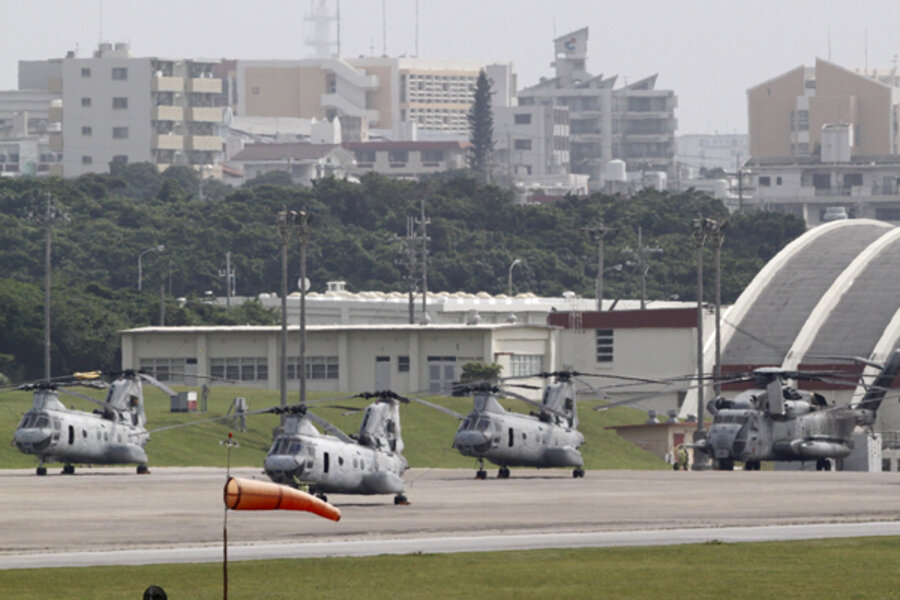How Japan, US may break 18-year deadlock over Okinawa base
Loading...
| Beijing
This week’s US-Japanese agreement removing thousands of Marines from Okinawa breaks an 18-year deadlock over the realignment of US forces in Japan by a simple expedient: sidestepping the key obstacle that has bedeviled the issue.
Both sides take something from the deal, announced Wednesday, which decouples the transfer of the Marines from Okinawa to Guam from the difficult question of relocating a controversial US airbase on the Japanese island.
Washington can get on with the reorganization of its military forces in the region as part of the “Pacific pivot” that President Obama announced last year, focusing US capabilities on East Asia. Tokyo can portray the departure of 8,000 Marines as progress to Okinawans who have long demanded a reduction in the number of American troops stationed on their island.
Okinawa plays reluctant host to nearly half of the 50,000 US troops stationed in Japan, including 18,000 Marines.
But though the agreement marks “movement in some direction,” it represents “only symbolic progress,” says Masaru Kohno, a politics professor at Waseda University in Tokyo.
The deal does not close the Futenma Marine airbase in the middle of Ginowa City, which residents complain is noisy and dangerous, and which successive Japanese governments have promised – and failed – to shutter.
Nor does it change longstanding plans to relocate the Futenma base to the less populated seaside village of Henoko, which Okinawa’s provincial governor has rejected and blocked for the past six years on environmental grounds.
Indeed, the US-Japanese joint statement called Futenma’s replacement by Henoko “the only viable way forward.” Japanese Foreign Minister Koichiro Gemba told reporters in Tokyo Wednesday that “we will never let the Futenma airbase remain fixed at the current location.”
In reality, however, there is little chance that Tokyo will be able to overcome local hostility to the Henoko plan, say analysts and politicians. “I see very, very little or no possibility of Henoko working,” acknowledges one senior foreign affairs official privately.
“There will be very difficult discussions between the government and the Okinawan people, but the most likely possibility is staying in Futenma,” he predicts.
Wednesday’s agreement leaves that stalemate unresolved, modifying a 2006 deal that foresaw the departure of 8,000 Marines, and the return of large swaths of land to Okinawan control, only when a Futenma replacement facility had been established.
It is still unclear where all the Marines and their 9,000 dependents will be moved to. Pentagon spokesman George Little said Wednesday that “it is premature to discuss troop numbers or specific locations associated with the relocation of Marines from Okinawa.”
Japanese officials, however, have said that 4,700 men will be moved to Guam, and the remaining 3,300 will be rotated around bases in Australia, Hawaii, and possibly the Philippines.
That would mark a change from original US plans to move all 8,000 Marines to Guam, part of a buildup on the Pacific island that could cost $23 billion, according to US government estimates.
Congressional Republicans cut the $150 million earmarked in the 2012 fiscal year Pentagon budget for the transfer of the Marines from Okinawa to Guam, saying they wanted to pressure Obama into finding cheaper alternatives.
That, however, prompted the Japanese government to slash its own contribution this year to the move by 85 percent from 2011 levels. It also eliminated entirely all spending on moving Futenma air base, pushing a solution to that problem even further into the distance.







